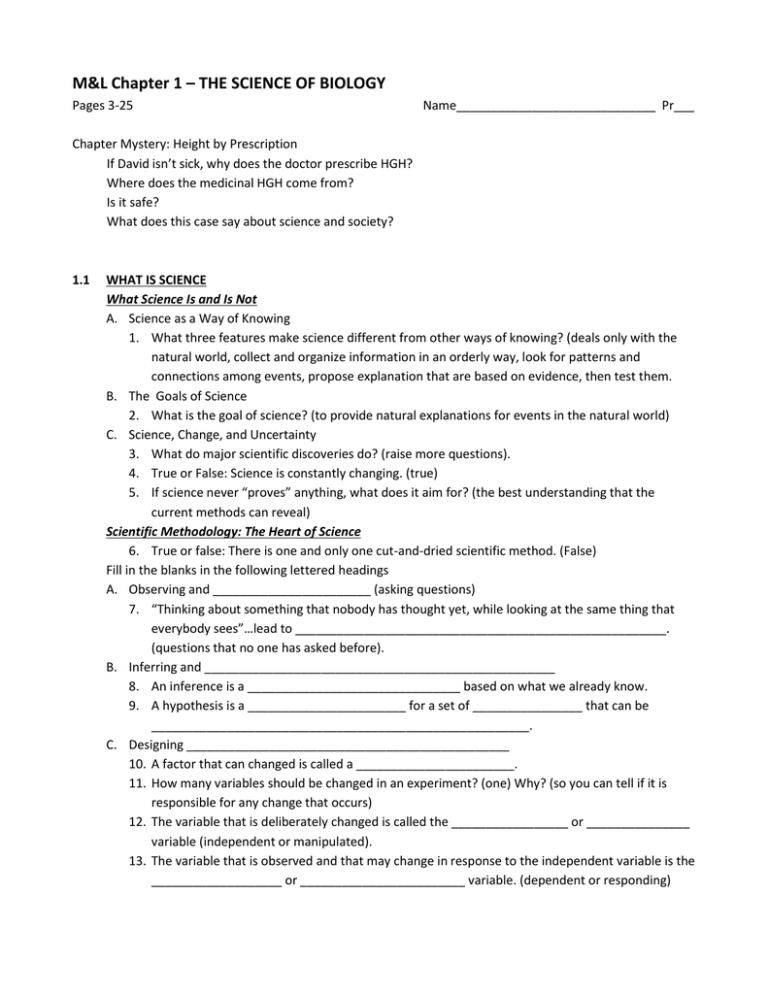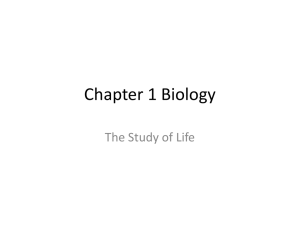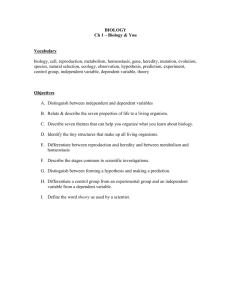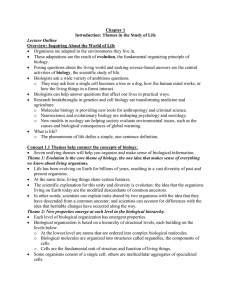M&L Chapter 1 – THE SCIENCE OF BIOLOGY
advertisement

M&L Chapter 1 – THE SCIENCE OF BIOLOGY Pages 3-25 Name_____________________________ Pr___ Chapter Mystery: Height by Prescription If David isn’t sick, why does the doctor prescribe HGH? Where does the medicinal HGH come from? Is it safe? What does this case say about science and society? 1.1 WHAT IS SCIENCE What Science Is and Is Not A. Science as a Way of Knowing 1. What three features make science different from other ways of knowing? (deals only with the natural world, collect and organize information in an orderly way, look for patterns and connections among events, propose explanation that are based on evidence, then test them. B. The Goals of Science 2. What is the goal of science? (to provide natural explanations for events in the natural world) C. Science, Change, and Uncertainty 3. What do major scientific discoveries do? (raise more questions). 4. True or False: Science is constantly changing. (true) 5. If science never “proves” anything, what does it aim for? (the best understanding that the current methods can reveal) Scientific Methodology: The Heart of Science 6. True or false: There is one and only one cut-and-dried scientific method. (False) Fill in the blanks in the following lettered headings A. Observing and _______________________ (asking questions) 7. “Thinking about something that nobody has thought yet, while looking at the same thing that everybody sees”…lead to ______________________________________________________. (questions that no one has asked before). B. Inferring and ___________________________________________________ 8. An inference is a _______________________________ based on what we already know. 9. A hypothesis is a _______________________ for a set of ________________ that can be _______________________________________________________. C. Designing _______________________________________________ 10. A factor that can changed is called a _______________________. 11. How many variables should be changed in an experiment? (one) Why? (so you can tell if it is responsible for any change that occurs) 12. The variable that is deliberately changed is called the _________________ or _______________ variable (independent or manipulated). 13. The variable that is observed and that may change in response to the independent variable is the ___________________ or ________________________ variable. (dependent or responding) 14. How is a control group different from the experimental group? (it’s not exposed to the independent or manipulated variable). 15. Why do scientists set up several sets of control and experimental groups? (book doesn’t really answer; “to reproduce or replicate their own observations.”) D. Collecting and Analyzing Data 16. Give an example of qualitative data. 17. Give an example of quantitative data. 18. Why should experimental and control groups be large in size (especially in medicine)? (because there is always variation among individuals; to be more reliable). E. Drawing Conclusions 19. After data from experiments is analyzed, the hypothesis that is being tested may be __________________, _________________, or _____________________. (supported, refuted, or revised). F. When Experiments Are Not Possible 20. Hypotheses about animal behavior are often tested using what kind of data? (observational or qualitative). 21. Why aren’t human subjects used for many tests? (it isn’t ethical) 1.2 SCIENCE IN CONTEXT Exploration and Discovery: Where ideas Come From A. Scientific Attitudes 22. What are the four habits of mind of a good scientist? (curiosity, skepticism, open-mindedness, and creativity) 23. Describe a situation where you were skeptical of a “fact” you had seen or heard. B. Practical Problems 24. Do all ideas for scientific investigations come from practical problems? (no) Where else do they come from? (curiosity) C. The Role of Technology 25. Technology, science, and _______________ are closely linked (society) Communicating Results: Reviewing and Sharing Ideas A. Peer Review 26. What do reviewers of scientific articles look for? (oversights, unfair influences, fraud, mistakes in techniques or reasoning). 27. Does peer review guarantee that a piece of work is correct? (no) B. Sharing Knowledge and New Ideas Scientific Theories 28. A scientific theory ties many ________________ together (hypotheses) 29. In daily life, a “theory” is a _________ (hunch). A scientist would not call it a theory but a _______________ (hypothesis). 30. Copy the definition of a theory here. “In science, the word theory applies to _______________________________________________________________________________ _______________________________________________________________________________ _______________________________________________________________________________ (a well-tested explanation that unifies a broad range of observations and hypotheses and that enables scientists to make accurate predictions about new situations.” 31. True or false: Theories are considered to be absolute truths by scientists. ___________ (False) Science and Society 32. Any question that involves the word “should” must be answered using a _______________ context, even if science can help inform the answer. (social, or moral) A. Science, Ethics, and Morality 33. True or False: Pure science does not involve ethical or moral viewpoints. ___________ (true) B. Avoiding Bias 34. A bias is a particular preference or _______________________ that is personal, rather than ____________________. (point of view; scientific). 35. Give an example of a bias that might influence a scientist. C. Understanding and Using Science 36. Who makes policy decisions in our society? (citizens). What do scientists do? (make recommendations). 1.3 STUDYING LIFE 37. What two Greek terms combine to form the word “biology,” and what does each mean? _________________________ and ________________________ (bios means “life” and –ology means “study of”) Characteristics of Living Things 38. True or False: Some non-living things share one or more traits of living organisms. ______(true) 39. True or False: There is one single trait that is enough to describe what makes something alive. ________ (false) Using the “Visual Summary,” fill in the following blanks which summarize the characteristics of all living things. 40. Living things are based on a ________________________________ (universal genetic code). a. The genetic code is written in the molecule called _________. (DNA) 41. Living things _________ and _________________. (grow and develop). 42. Living things respond to _____________________________ (their environment) 43. Living things are made up of ________ (cells) 44. Living things ____________________________. Most plants and animals use _______________ reproduction, reproducing organsims with new combinations of DNA. Other organisms use ____________________ reproduction, making identical copies of themselves. 45. Living things maintain a _______________________________________________ (stable internal environment). Maintaining this is called ____________________ (homeostasis) 46. Living things maintain and use ____________________________________ (material and energy). The chemical reactions through which organisms build up and break down materials is called _____________________ (metabolism). 47. Taken as a group, living things ________________ (evolve). Big Ideas in Biology The study of biology revolves around several interlocking big ideas. Fill in the following blanks which summarize these. 48. The _________________ basis of life (cellular). Living things are made of cells. If they are made of one cell they are __________________; if they are made of two or more cells they are _______________________________. (multicellular). Cells in multicellular organisms perform different tasks, so they differ in _______, _______________, and _________________. (size, shape, function) 49. Information and ________________, coded in the ___________. (heredity; DNA) 50. Matter and _______________, the need for which link all living organisms in a ______________________________________________ (energy; web of interdependent relationships) 51. Growth, ____________________, and _________________________. (reproduction and development) 52. ____________________, meaning that organisms maintain a relatively stable internal environment. (homeostasis) 53. ____________________, or change in populations over time, linking all organisms to a common ancestor some 3.5 billion years ago. (evolution) 54. Structure and _______________________, meaning that how something is built will determine what it can do. (function) 55. Unity and __________________ of life. All organisms are composed of a common set of _____________________________, store information in a common _________________________, and use ____________ to build their structures and carry out their functions. (diversity; carbon-based molecules; genetic code; proteins) 56. _________________________in Nature, meaning all forms of life are connected in the _______________________ due to the _______________ of matter and the ________________ of energy. (Interdependence; biosphere; cycling; flow) 57. Science as a _______________________, using ___________________, questions, and ______________________ to explain the natural world in terms of ______________ forces and events. (way of knowing, observations, experiments, natural) Fields of Biology 58. Using on line resources, name ten different fields of biology and what each studies. I’ve done the first one for you. a. Entomologists study insects Performing Biological Investigations A. Scientific Measurement 59. What measurement system do scientists use? ______________________ (metric). It is based on multiples of ___________ (ten). B. Safety 60. Name two important safety rules. a. ______________________________________________________________________ b. ______________________________________________________________________ Review Section 1.1 Title What is Science? 1.2 Science in Context 1.3 Key Questions What are the goals of science? What procedures are at the core of scientific methodology? What scientific attitudes help generate new ideas? Why is peer review important? What is a scientific theory? What is the relationship between science and society? Studying What characteristics do all living things share? Life What are the central themes of biology? How do different fields of biology differ in their approach to studying life? How is the metric system important in science? Vocabulary Science, Observation, inference, hypothesis, controlled experiment, independent variable, dependent variable, control group, data. Theory, bias Biology, DNA, stimulus, sexual reproduction, asexual reproduction, homeostasis, metabolism, biosphere








